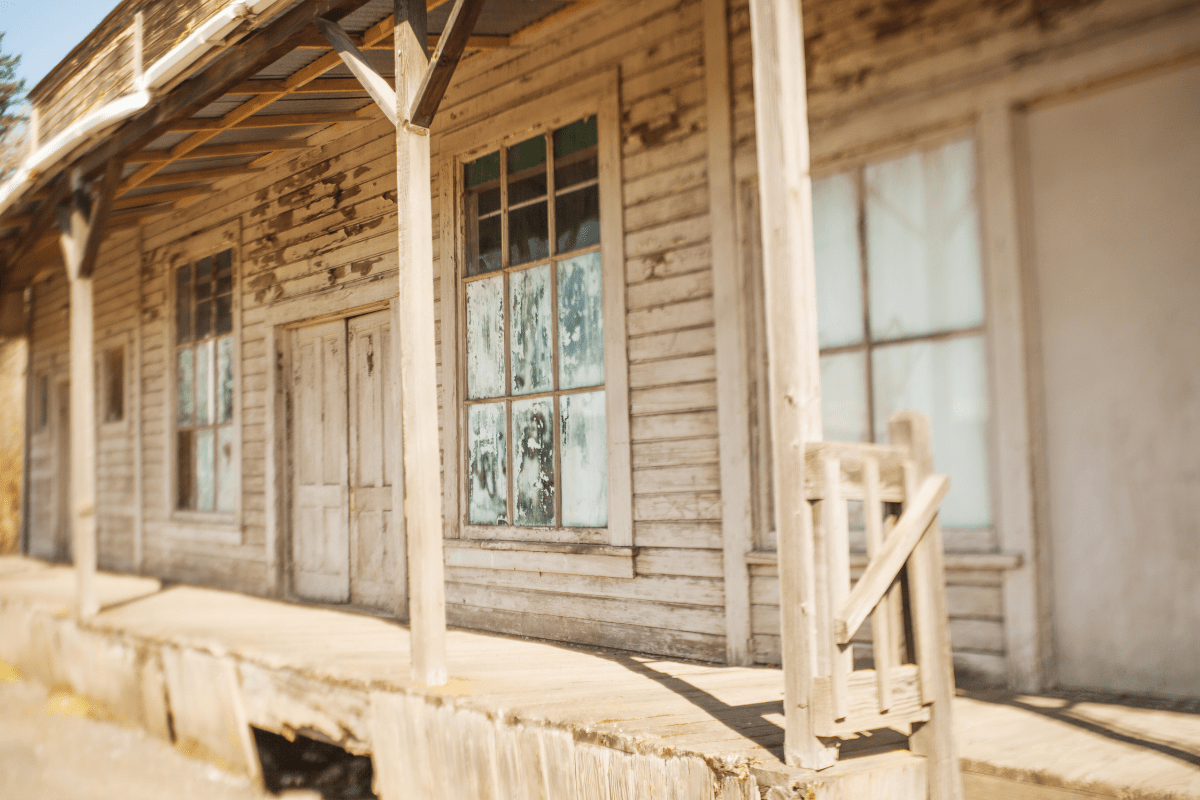So you want to explore ghost towns in Illinois? Good news: we've got 84 documented ones scattered across the state, and unlike those clickbait articles that just list names without telling you if you'll get arrested for visiting, I'm going to give you the real details you need.
Let me paint you a picture of what's happening in Illinois right now. Since 2010, 87 of our 102 counties have been hemorrhaging people faster than a punctured water balloon. We're talking about 980 out of 1,294 incorporated places that got smaller between 2022 and 2023. That's not just statistics… that's entire communities becoming the ghost towns of tomorrow while we watch.
Before you go: The stuff that keeps you out of jail
Here's the thing nobody tells you until it's too late: trespassing in Illinois is a Class B misdemeanor that can land you six months in jail and a $1,500 fine. Yes, even if the building looks abandoned. Yes, even if there's no fence. And here's a fun rural Illinois fact I learned the hard way: purple paint on trees or posts? That's legally the same as a "No Trespassing" sign. Who knew?
The best times to visit are September through October or April through May. Trust me on this one. Summer in Illinois is like exploring inside a wet sock, and winter makes half these places inaccessible unless you fancy getting your car stuck in mud that won't thaw until March.
Safety gear you actually need
Look, I'm not your mom, but abandoned buildings are basically tetanus theme parks. The Illinois Department of Natural Resources has sealed 1,236 hazardous mine openings across the state, which means there are probably at least that many they haven't found yet. Here's your shopping list:
- N95 respirator (asbestos is real)
- Sturdy boots (tetanus shots are expensive)
- Hard hat (ceilings have trust issues)
- First aid kit (obviously)
- Flashlight plus backup (darkness is darker than expected)
- Someone who knows where you went
Southern Illinois: Where the best stories live
Southern Illinois wins the ghost town lottery, hands down. These aren't just abandoned places… they're abandoned places with genuinely wild backstories.
Old Shawneetown: The town that refused Chicago's money
Old Shawneetown is my favorite because you can actually visit without sneaking around like a teenager. Located at GPS coordinates 37.698197, -88.136857, this place still has 113 residents living among the ruins, which creates this bizarre time-warp effect that's hard to describe.
Here's my favorite Old Shawneetown story: Back in the 1830s, Chicago asked the local bank for a loan to help build their city. The Shawneetown bankers literally laughed them out of the building, saying no city "that far from a navigable river could survive." The bank building is still there, by the way, and you can visit it. I like to imagine the ghosts of those bankers watching Chicago's skyline on Google Earth and feeling pretty stupid.
The 1937 Ohio River flood put every single building underwater, which is why most people left. But the Shawneetown Bank State Historic Site (built between 1839 and 1841) survived, along with the John Marshall House Museum. Just take Illinois Route 13 straight through town. No special permissions needed, no purple paint to worry about.
Kaskaskia: Illinois' geographic identity crisis
Okay, this one's weird even by ghost town standards. Kaskaskia is technically in Illinois but you have to drive through Missouri to get there. Why? Because in 1881 the Mississippi River basically said "screw your state borders" and changed course, stranding Illinois' first state capital on the wrong side of the river.
Only 21 people live there now, making it Illinois' third-smallest incorporated community. But the Church of the Immaculate Conception still has this 650-pound bronze bell that King Louis XV gave them in 1741, which they call the "Liberty Bell of the West." The Pierre Menard Home from 1802 is also worth seeing if you make the weird Missouri detour to get there.
Local folklore says the town is cursed, which… I mean, when your town ends up on the wrong side of the Mississippi River through no fault of your own, maybe they have a point?
Cairo: Still technically inhabited
Cairo breaks my heart a little. In the 1920s, this river port had 15,000 residents. Today? Barely 2,000, and most of them would leave if they could afford to. During the Great Depression, Cairo had Illinois' highest murder rate and supposedly 1,000 of its 15,000 residents worked as prostitutes, which really puts things in perspective.
The 1967 racial riots and the White Hats vigilante group pretty much finished what the economy started. But here's something hopeful: Rise Community Market opened in 2024, the first grocery store in seven years. So maybe Cairo's not quite done yet.
If you're into paranormal stuff (no judgment), people report weird things at the A.B. Safford Memorial Library and the abandoned Southern Medical Center that closed in 1986. I'm skeptical, but I also didn't stick around after dark to test it.
Central Illinois: Coal country graveyards
Central Illinois ghost towns all tell basically the same story: coal made them, coal killed them. It's like a Shakespearean tragedy but with more mining equipment.
Cardiff: Explosive personality
Cardiff in Livingston County (41°3'6"N, 88°17'13"W for you GPS folks) speedran the whole boom-to-bust cycle in just 13 years. Founded in 1899 to mine coal for the Wabash Railroad, it had 500 miners at its peak. Then in 1903, they had not one but TWO mine explosions on the same day that killed eight miners total. When the coal quality went downhill and the railroad stopped buying in 1912, everybody just… left.
Today, the only things marking Cardiff's location are two massive mine waste hills and a historical marker from 2007. It's like the world's saddest monument, but also kind of impressive in a "nature always wins" sort of way.
The thing about these mining ghost towns is they're legitimately dangerous to explore. Illinois went from 1,350 active mines in 1935 to about 20 today. All those old mines? They're just sitting there, slowly collapsing and leaking whatever chemicals they used back when workplace safety was considered optional.
Northern Illinois: The accessible options
Northern Illinois ghost towns are like the starter pack for urban exploration… easier to access, less likely to kill you, generally more family-friendly.
Millville: Completely and thoroughly gone
Millville gets the award for "most thoroughly destroyed town." It's now part of Apple River Canyon State Park (42°26'56"N, 90°03'05"W), which means you can visit legally and there's actual parking. Win-win.
Founded in 1835 as a sawmill town, Millville was doing great with 300 residents until 1892 when the Cox Mill dam burst and a flood literally deleted the entire town. Not damaged. Not partially destroyed. Completely, utterly gone. Archaeologists have found some ceramic fragments and foundations about 70-80 centimeters underground, but that's it.
The good news is it's super easy to visit. From Stockton, take Highway 78 north for six miles, then turn west on E. Canyon Road. Standard state park entrance fees apply, but you get parking, trails, and interpretive materials. Just don't bring a metal detector… it's illegal and you'll only find disappointment anyway.
Clayville: Ghost town lite
If you want the ghost town experience but with, you know, actual buildings and bathrooms, Clayville Historic Site near Pleasant Plains is your spot. Located at 12828 State Route 125, they've basically recreated an entire 1820s village around the original Broadwell Inn.
The coolest part? Abraham Lincoln was the inn-keeper's lawyer four different times, so you can add "Lincoln slept here" to your ghost town bingo card. They've got the Batterton Cabin from 1817 (Sangamon County's oldest building), a relocated log schoolhouse, and a blacksmith shop. It's like Colonial Williamsburg but with less budget and more Illinois.
The bigger picture: Why these towns keep dying
Here's something depressing but important: Illinois has experienced ten consecutive years of population decline from 2014 to 2023. In 2022 alone, 85% of Illinois communities lost people. Ninety-seven percent of people leaving cite high taxes as their main reason, which… yeah, that tracks.
Dr. Christopher Fennell, an anthropologist at the University of Illinois who studies these sites, puts it perfectly: "These towns weren't simply abandoned, they were undone by floods that redrew the landscape, railroads that chose other paths, industries that collapsed, and political decisions that left them stranded."
Preservation wins and losses
Not everything is doom and gloom though. New Philadelphia just got designated as a National Historic Site in December 2024. It was the first legally incorporated African American town before the Civil War, and Dr. Fennell's team recovered 85,000 artifacts from 14 buildings there. Sometimes the good guys win.
The Illinois State Archaeological Survey keeps records on over 3,000 historic sites with 12,000 cubic feet of materials. Their director, Dr. Timothy Pauketat, says something that stuck with me: "The struggle over history is really a struggle over the future." Heavy, but true.
How to actually visit these places without being an idiot
Let's get practical. Some towns are totally open to visitors, others will definitely get you arrested. Here's your cheat sheet:
The freely accessible ones:
- Old Shawneetown (just drive through)
- Clayville Historic Site (regular hours)
- Millville (state park rules apply)
The "it's complicated" ones:
- Kaskaskia (accessible but weird Missouri detour)
- Cardiff (private property, visible from road)
- Cairo (inhabited but depressing)
The "definitely need permission" ones:
- Brownsville (entirely private farmland)
- Most mining sites (dangerous and illegal)
If you want to play it safe, the McHenry County Historical Society runs guided ghost town bus tours. Yeah, it's touristy, but it's also legal and someone else drives.
The paranormal thing (because someone always asks)
Look, I'm not saying ghosts are real, but Troy Taylor literally moved to Alton to research hauntings, so somebody's taking this seriously. The reported phenomena includes everything from mysterious chair squeaking at Cairo's library to full-on ghost funeral parades at Fort De Chartres that supposedly only happen when July 4th falls on a Friday.
The abandoned Southern Medical Center in Cairo seems to be paranormal investigation central. People report getting scratched and experiencing "unexplained encounters," which could mean anything from actual ghosts to tetanus from rusty medical equipment. Personally, I think the real horror is the asbestos, but you do you.
Final thoughts from someone who's been there
After visiting dozens of these places, here's what stays with me: These weren't just dots on a map. Real people lived here, had hopes here, gave up and left here. Kevin Snell's grandfathers worked in Gale, describing how "they would get the cattle and other livestock off and feed them" at the railroad roundhouse. One Cairo resident told a reporter they stay "because they have no place else to go."
Historian Neil Gale said it best: "History isn't just what survives, it's also what we choose to remember."
So yes, go explore Illinois ghost towns. Take pictures, learn the stories, respect the "No Trespassing" signs (especially the purple paint ones). But remember you're walking through someone's former life, someone's abandoned dream. These places deserve better than just being Instagram backdrops.
Pack your safety gear, check the property records, maybe spring for that tetanus shot. And if you find something cool, share it responsibly. These towns have already been forgotten once. They don't need to be destroyed by people who learned about them from articles like this one.
Happy exploring, and seriously, watch out for the purple paint.





